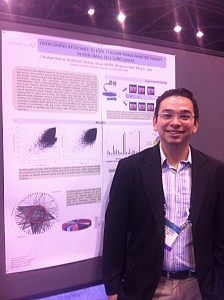Highlights of AACR 2012 – Part 2
Yesterday, I mentioned that some of the best bits of this year’s American Association for Cancer Research (AACR) meeting were the numerous gems in the poster sessions.
One of the coolest such posters I came across was from Ming Tsao’s group.
Specifically, Rafael Sierra (see photo right) was hosting an excellent piece of research entitled: “Overcoming resistance to EGFR-tyrosine kinase inhibitor therapy in non-small cell lung cancer.”
This is an area of much needed research and breakthroughs.
Why?
Well, at the ECCO meeting in Stockholm last September, Tom Lynch was discussing the role of one such EGFR therapy, cetuximab (Erbitux), in lung cancer and wearily declared prior to presenting a negative study,
“If ever there was a drug desperately needing a biomarker, it’s cetuximab”
because while some of the patients responded beautifully to the drug, many others didn’t and at that time, there was no way to determine upfront who might respond before treating.
This is clearly a waste of valuable resources and time because catch-all studies mean that the number of negative responses can balance out the positive responses in too heterogeneous a population. That said, if you know what the potential target(s) or biomarker of response are, then you can select patients more precisely for a study and improve the subsequent overall response rates and OS advantage dramatically.
As Sierra et al., pointed out in their poster at AACR, we do know that:
“Patients that present amplification or activating mutations (L878R or exon 19 deletions) of EGFR, have higher response rates. Selection improved response rates from less than 10% to over 60–80%.”
This is very good progress, but how did their research take this concept further?
In this study, the group reported the preliminary findings from a complex study of genome-wide screenings on EGFR resistant cells to try and identify new genes that might mediate resistance and, importantly, be potentially druggable, unlike say, MYC. This would then offer new logical targets for combination therapies to be tested in the clinic in patients to determine if outcomes could be improved.
At the time of the poster presentation, the group had indeed identified a short list of potential candidates (not named as this would be available in a later publication). Conceptually though, this was an elegant study and I really liked the concept.
This morning, I was delighted to see a news snippet from the 3rd European Lung Cancer Conference in Geneva, Switzerland where the ESMO press release noted that Dr Tsao’s group performed:
“An exploratory analysis on the TORCH patient tumor samples that were available for analysis, looking for molecular biomarkers known to be potential predictors of benefit from EGFR inhibitors.”
Despite the biomarker analysis being pre-planned, however, only a third (36%) of samples were available for analysis. It is always harder to do retrospective mutation analysis on small sample sizes unless rigorously collected as per the BATTLE trials.
I’m looking forward to hearing what targets were identified in Drs Sierra and Ming’s research once published or presented in more detail at a future conference, as this may help us move the field forward in terms of rational combinations to either overcome resistance to EGFR therapy (other than the well known T790M mutation) or prevent resistance from developing early.
Now, that would be very cool and I do hope they alert us to the publication in due course – watch this space!

2 Responses to “Highlights of AACR 2012 – Part 2”
Available therapies for lung cancer mutations in the UK are extremely limited so any development in research that might influence the available alternatives here are much welcomed – look forward to hearing more.
Sadly that sounds like when NICE is not so NICE, Elaine. The reverse here is true here in the US – more therapies available, but at a steep cost to patients and insurers.
Comments are closed.